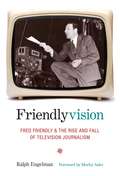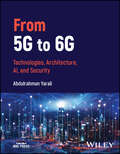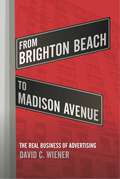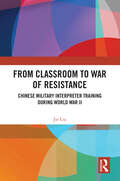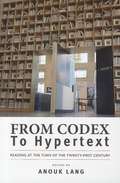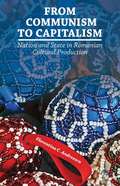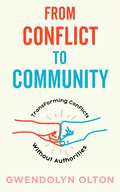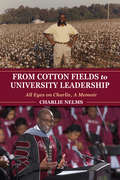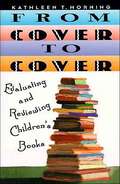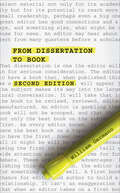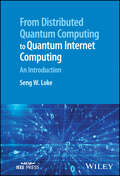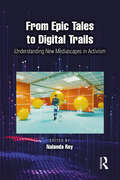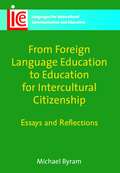- Table View
- List View
Friend & Foe: When to Cooperate, When to Compete, and How to Succeed at Both
by Adam Galinsky Maurice SchweitzerWhat does it take to succeed? This question has fueled a long-running debate. Some have argued that humans are fundamentally competitive, and that pursuing self-interest is the best way to get ahead. Others claim that humans are born to cooperate and that we are most successful when we collaborate with others. In FRIEND AND FOE, researchers Galinsky and Schweitzer explain why this debate misses the mark. Rather than being hardwired to compete or cooperate, we have evolved to do both. In every relationship, from co-workers to friends to spouses to siblings we are both friends and foes. It is only by learning how to strike the right balance between these two forces that we can improve our long-term relationships and get more of what we want.Here, Galinsky and Schweitzer draw on original, cutting edge research from their own labs and from across the social sciences as well as vivid real-world examples to show how to maximize success in work and in life by deftly navigating the tension between cooperation and competition. They offer insights and advice ranging from: how to gain power and keep it, how to build trust and repair trust once it's broken, how to diffuse workplace conflict and bias, how to find the right comparisons to motivate us and make us happier, and how to succeed in negotiations - ensuring that we achieve our own goals and satisfy those of our counterparts.Along the way, they pose and offer surprising answers to a number of perplexing puzzles: when does too much talent undermine success; why can acting less competently gain you status and authority, where do many gender differences in the workplace really come from, how can you use deception to build trust, and why do you want to go last on American Idol and in many interview situations, but make the first offer when negotiating the sale of a new car.We perform at our very best when we hold cooperation and competition in the right balance. This book is a guide for navigating our social and professional worlds by learning when to cooperate as a friend and when to compete as a foe--and how to be better at both.
Friendlyvision: Fred Friendly and the Rise and Fall of Television Journalism
by Ralph EngelmanFred Friendly (1915-1998) was the single most important personality in news and public affairs programming during the first four decades of American television. Portrayed by George Clooney in the film Good Night and Good Luck, Friendly, together with Edward R. Murrow, invented the television documentary format and subsequently oversaw the birth of public television. Juggling the roles of producer, policy maker, and teacher, Friendly had an unprecedented impact on the development of CBS in its heyday, wielded extensive influence at the Ford Foundation under the presidency of McGeorge Bundy, and trained a generation of journalists at Columbia University during a tumultuous period of student revolt. Ralph Engelman's biography is the first comprehensive account of Friendly's life and work. Known as a "brilliant monster," Friendly stood at the center of television's unique response to McCarthyism, Watergate, and the Vietnam War, and the pitched battles he fought continue to resonate in the troubled world of television news. Engelman's fascinating psychological portrait explores the sources of Friendly's legendary rage and his extraordinary achievement. Drawing on private papers and interviews with colleagues, family members, and friends, Friendlyvision is the definitive story of broadcast journalism's infamous "wild man," providing a crucial perspective on the past and future character of American journalism.
Friendlyvision: Fred Friendly and the Rise and Fall of Television Journalism
by Ralph EngelmanFred Friendly (1915-1998) was the single most important personality in news and public affairs programming during the first four decades of American television. Portrayed by George Clooney in the film Good Night and Good Luck, Friendly, together with Edward R. Murrow, invented the television documentary format and subsequently oversaw the birth of public television. Juggling the roles of producer, policy maker, and teacher, Friendly had an unprecedented impact on the development of CBS in its heyday, wielded extensive influence at the Ford Foundation under the presidency of McGeorge Bundy, and trained a generation of journalists at Columbia University during a tumultuous period of student revolt.Ralph Engelman's biography is the first comprehensive account of Friendly's life and work. Known as a "brilliant monster," Friendly stood at the center of television's unique response to McCarthyism, Watergate, and the Vietnam War, and the pitched battles he fought continue to resonate in the troubled world of television news. Engelman's fascinating psychological portrait explores the sources of Friendly's legendary rage and his extraordinary achievement. Drawing on private papers and interviews with colleagues, family members, and friends, Friendlyvision is the definitive story of broadcast journalism's infamous "wild man," providing a crucial perspective on the past and future character of American journalism.
Friendship in the Age of Loneliness: An Optimist's Guide to Connection
by Adam Smiley PoswolskyAfter nearly a year of social distancing and lockdown measures, it&’s more clear than ever that our friendships and bonds are vital to our health and happiness. This refreshing, positive guide helps you take care of your people and form deep connections in the digital age. We are lonelier than ever. The average American hasn't made a new friend in the last five years.Research has shown that people with close friends are happier, healthier, and live longer than people who lack strong social bonds. But why—when we are seemingly more connected than ever before—can it feel so difficult to keep those bonds alive and well? Why do we spend only four percent of our time with friends?In this warm, inspiring guide, Adam "Smiley" Poswolsky proposes a new solution for the mounting pressures of modern life: focus on your friendships. Smiley offers practical habits and playful reminders on how to create meaningful connections, make new friends, and deepen relationships. He'll help you develop a healthier relationship with technology, but he'll also encourage you to prioritize real-world experiences, send snail mail, and engage in self-reflective exercises.Written in short, digestible, action-oriented sections, this book reminds us that nurturing old and new friendships is a ritual, a necessity, and one of the most worthwhile things we can do in life.
Friendshipping: The Art of Finding Friends, Being Friends, and Keeping Friends
by Jenn Bane Trin GarritanoWith eight billion people in the world, why is it so hard to meet and make new friends? Navigating the world of adult friendships can be a real challenge when everyone is busy, overwhelmed, or too often too far away. Here to help are Jenn Bane and Trin Garritano, the duo behind the cult favorite podcast Friendshipping. Insightful, empathetic, and just a touch irreverent, Jenn and Trin give readers the tools they need to make new friends and revitalize the quality of existing friendships. The book covers it all: Meeting new peopleMastering the art of small talkDeciphering the levels of friendship in the workplaceMaking the first friend move, plus how to give a non-creepy compliment You&’ll also learn why it&’s important to use the same IRL etiquette when making friends online; how to decide if a friendship is toxic and know when it&’s time to move on; and most important, how to be a better friend, to yourself and others.
Frientimacy: How to Deepen Friendships for Lifelong Health and Happiness
by Shasta NelsonWith the constant connectivity of today's world, it's never been easier to meet people and make new friends-but it's never been harder to form meaningful friendships.In Frientimacy, award-winning speaker Shasta Nelson shows how anyone can form stronger, more meaningful friendships, marked by a level of trust she calls "frientimacy." Shasta explores the ten most common complaints and conflicts facing female friendships today, and lays out strategies for overcoming these pitfalls to create deeper, supportive relationships that last for the long-term.Shasta is the founder of girlfriendcircles.com, a community of women seeking stronger, more fulfilling friendships, and the author of Friendships Don't Just Happen. In Frientimacy, she teaches readers to reject the impulse to pull away from friendships that aren't instantly and constantly gratifying. With a warm, engaging, and inspiring voice, she shows how friendships built on dedication and commitment can lead to enriched relationships, stronger and more meaningful ties, and an overall increase in mental health.The Intimacy Gap is more than just a call for deeper connection between friends; it's a roadmap for moving from friendship to frientimacy-and the meaningful and satisfying relationships that come with it.
From 5G to 6G: Technologies, Architecture, AI, and Security
by Abdulrahman YaraliFrom 5G to 6G Understand the transition to the sixth generation of wireless with this bold introduction The transition from the fifth generation of wireless communication (5G) to the coming sixth generation (6G) promises to be one of the most significant phases in the history of telecommunications. The technological, social, and logistical challenges promise to be significant, and meeting these challenges will determine the future of wireless communication. Experts and professionals across dozens of fields and industries are beginning to reckon seriously with these challenges as the 6G revolution approaches. From 5G to 6G provides an overview of this transition, offering a snapshot of a moment in which 5G is establishing itself and 6G draws ever nearer. It focuses on recent advances in wireless technology that brings 6G closer to reality, as well as the near-term challenges that still have to be met for this transition to succeed. The result is an essential book for anyone wishing to understand the future of wireless telecommunications in an increasingly connected world. From 5G to 6G readers will also find: 6G applications to both AI and Machine Learning, technologies which loom ever larger in wireless communication Discussion of subjects including smart healthcare, cybersecurity, extended reality, and more Treatment of the ongoing infrastructural and technological requirements for 6G From 5G to 6G is essential for researchers and academics in wireless communication and computer science, as well as for undergraduates in related subjects and professionals in wireless-adjacent fields.
From Author to Reader: A Social Study of Books (Routledge Revivals)
by Peter H MannOriginally published in 1982, From Author to Reader, the first of its kind, is a complete review of books in modern society that draws upon the author’s own and many other published sources concerning the social aspects of books. It looks at the roles played by authors, publishers, booksellers, and librarians in bringing books to readers. It further examines the behaviour of book readers themselves. Dr Mann’s arguments are well supported by unobtrusive statistical data. Dealing as it does with so many aspects of the book as a medium of communication, From Author to Reader tells a fascinating story which will interest everyone who uses books for work or leisure.
From Black Sox to Three-Peats: A Century of Chicago's Best Sportswriting from the Tribune, Sun-Times & Other Newspapers
by Ron RapoportBears, Bulls, Cubs, Sox, Blackhawks—there’s no city like Chicago when it comes to sports. Generation after generation, Chicagoans pass down their almost religious allegiances to teams, stadiums, and players and their never-say-die attitude, along with the stories of the city’s best (and worst) sports moments. And every one of those moments—every come-from-behind victory or crushing defeat—has been chronicled by Chicago’s unparalleled sportswriters. In From Black Sox to Three-Peats, veteran Chicago sports columnist Ron Rapoportassembles one hundred of the best columns and articles from the Tribune, Sun-Times, Daily News, Defender, and other papers to tell the unforgettable story of a century of Chicago sports. From Ring Lardner to Rick Telander, Westbrook Pegler to Bob Verdi, Mike Royko to Hugh Fullerton , Melissa Isaacson to Brent Musburger, and on and on, this collection reminds us that Chicago sports fans have enjoyed a wealth of talent not just on the field, but in the press box as well. Through their stories we relive the betrayal of the Black Sox, the cocksure power of the ’85 Bears, the assassin’s efficiency of Jordan’s Bulls, the Blackhawks’ stunning reclamation of the Stanley Cup, the Cubs’ century of futility—all as seen in the moment, described and interpreted on the spot by some of the most talented columnists ever to grace a sports page. Sports are the most ephemeral of news events: once you know the outcome, the drama is gone. But every once in a while, there are those games, those teams, those players that make it into something more—and great writers can transform those fleeting moments into lasting stories that become part of the very identity of a city. From Black Sox to Three-Peats is Chicago history at its most exciting and celebratory. No sports fan should be without it.
From Brighton Beach to Madison Avenue
by David C. WienerUnlike any accountant most people ever meet, David C. Wiener rose from humble beginnings in a Jewish neighborhood of Brighton Beach, to the heights of accounting success by carving out a niche in the advertising industry in midtown Manhattan. He moved from accounting to financial assessment to negotiating deals with an ever widening array of companies. His uncanny ability to size up in an instant a situation on all levels—not only financial and economic, but all aspects related to it—his disarming sense of humor, and his no-nonsense approach make him the perfect deal maker. This book lifts the curtain on the stage of advertising agencies from the 1970s to the present and shares life lessons on how to succeed in business and in life.
From Classroom to Career: How to Network, Nail the Interview, and Navigate for Success
by Shirley MorrisonAn authentic, engaging, and practical guide to help college grads thrive personally and professionally.The rules have changed; the traditional workplace is dead. To BOOM in employment today, the secret is to alter the approach, and From Classroom to Career will tell you how. Gen Z and Millennials are asking for this value-led guide as they embark on careers.Entertaining, personal, and relatable, the voice of the book is purposely casual, as if speaking in a café. It&’s a voice everyone trusts. Reasonable, logical, and concrete advice for today&’s how-to: how to write a business email; how to successfully land and then stand out in an interview, including in a virtual world; how to ask questions that can be adapted to any job/role; how to write a CV with examples. Inspiring, surprising, real-life stories show empathy for what the readers are likely going through, so they&’ll forget it&’s a business book.From Classroom to Career integrates the personal and career. This is in fact the real reality of every human being: we&’re so much more than careerists. It&’s impossible to thrive career-wise if you are not happy outside of work. People are happier when they have a balance, enabling them to achieve personally and professionally. By helping readers to discover their own values, this guide gets them to think about their own career and who they want to be. This is entirely unlike any other business book out there.
From Classroom to War of Resistance: Chinese Military Interpreter Training during World War II
by Jie LiuThis book focuses on a long- neglected yet important topic in China’s translation history: interpreter/ translator training and wartime translation studies. It examines the military interpreter training programmes after the outbreak of the Pacific War (1941–1945), further revealing the indispensable role of translation and interpreting in war. The author explores the relationship between linguistic education and war context in the China- Burma- India Theatre, where international cooperation was salient. Some 4,000 interpreting officers played a vital role in assisting in air defence, transportation, training of the Chinese army and coordinating expeditionary operations. The book seeks to bring these interpreters to life, telling the stories of why they joined the war, how they were trained and what they did in the war. Through the study of training programmes, historical archives, accounts and trainees’ memoirs, discussions revolve around key strands of education, including curriculums, textbooks and training methods. Utilising foreign language education practices as its main case study, the book analyses these through the framework of linguistic and translation theories. The book contributes to Chinese interpreting history by exploring its first-ever nationwide professional interpreting (and translation) training practices, and will inspire scholars of translation/ interpreting training, world modernhistory and foreign language education in general.
From Codex to Hypertext: Reading at the Turn of the Twenty-First Century
by Anouk LangThis volume includes essays that consider how changes such as the mounting ubiquity of digital technology and the globalization of structures of publication and book distribution are shaping the way readers participate in the encoding and decoding of textual meaning. Contributors also examine how and why reading communities cohere in a range of contexts, including prisons, book clubs, networks of zinesters, state-funded programs designed to promote active citizenship, and online spaces devoted to sharing one's tastes in books.
From Communism to Capitalism
by Florentina C. AndreescuThis book offers an interdisciplinary mode of analyzing transitions from communism and planned economy to democracy and capitalism focusing on how the various social and political transformations are reflected within one hundred Romanian films produced during communism, transition, and post-transition.
From Conflict to Community: Transforming Conflicts Without Authorities
by Gwendolyn OltonConflict is everywhere: our living rooms, our streets, our community organizations, and every corner of the internet. But few of us have the training to successfully intervene or resolve these conflicts. In these pages, experienced peacemaker Gwendolyn Olton shows you how to use your existing skills and intuition to transform a wide variety of conflicts from insurmountable impasses to working relationships where everyone's needs are met. The result is a practical, kind, realistic guidebook for anyone who's found themselves in a conflict (their own or someone else's) and wondered, "How did we get here and what can I do to make it better!?"The book is broken up into three sections: learn the basics of conflicts, help others work out their conflicts, and finally, resolve and heal the conflicts in your own life. Filled with real life examples and thought-provoking scenarios, Olton offers a variety of conflict analysis and conversation tools that you can use to navigate the most challenging interpersonal dynamics, and to better understand yourself and others along the way—all without calling HR or the cops.
From Conflict to Courage: How to Stop Avoiding and Start Leading
by Marlene ChismA framework to help managers defuse disagreements in the workplace and turn conflict into an opportunity for growth. Unresolved workplace conflict wastes time, increases stress, and negatively affects business outcomes. But conflict isn't the problem, mismanagement is. Leaders unintentionally mismanage conflict when they fall into patterns of what Marlene Chism calls &“the Three As:&” aggression, avoidance, and appeasing. &“These coping mechanisms are ways human beings avoid the emotions that come with conflict,&” says Chism. In this book she shows how to fearlessly deal with conflict head-on by expanding your conflict capacity. Conflict capacity is a combination of three elements. The foundation is the Inner Game—the leader's self-awareness, values, discernment, and emotional integrity. The Outer Game is the skills, tools, and communication techniques built on that foundation. Finally, there's Culture—the visible and invisible structures around you that can encourage or discourage conflict. Chism offers exercises, examples, and expert guidance on developing all three elements. Leaders will discover techniques to increase leadership clarity, identify obstacles, and reduce resistance. They'll develop powerful skills for dealing with high-conflict people and for initiating, engaging in, and staying with difficult conversations. Readers will learn that when they see conflict as a teacher, courageously face it, and continually work on transforming themselves, they can get the resolution they are seeking. They can change minds. &“A very practical and excellent how-to guide.&” —Bill Stoller, CEO and founder, Express Employment Professionals &“An actionable blueprint for how to handle . . . difficult conversations.&” —Tanveer Naseer, MS, Inc. Top 100 leadership and management expert, author of Leadership Vertigo
From Cotton Fields to University Leadership: All Eyes on Charlie, A Memoir
by Charlie NelmsThe renowned leader in higher education provides “a testament to the power of aspiration, character and education to overcome poverty and adversity” (Michael L. Lomax, President & CEO, United Negro College Fund).Charlie Nelms had audaciously big dreams. Growing up black in the Deep South in the 1950s and 1960s, working in cotton fields, and living in poverty, Nelms dared to dream that he could do more with his life than work for white plantation owners sun-up to sun-down. Inspired by his parents, who first dared to dream that they could own their own land and have the right to vote, Nelms chose education as his weapon of choice for fighting racism and inequality.With hard work, determination, and the critical assistance of mentors who counseled him along the way, he found his way from the cotton fields of Arkansas to university leadership roles. Becoming the youngest and the first African American chancellor of a predominately white institution in Indiana, he faced tectonic changes in higher education during those ensuing decades of globalization, growing economic disparity, and political divisiveness. From Cotton Fields to University Leadership is an uplifting story about the power of education, the impact of community and mentorship, and the importance of dreaming big.“In his memoir, the realities of his life take on the qualities of a good docudrama, providing the back story to the development of a remarkable educational leader. His is ‘the examined life,’ filled with honesty, humor, and humility. While this is uniquely Charlie’s story, it is a story that will lift the hearts of many and inspire future generations of leaders.” —Betty J. Overton, Director, National Forum on Higher Education for the Public Good
From Cotton Fields to University Leadership: All Eyes on Charlie, A Memoir (Well House Books)
by Charlie NelmsThe renowned leader in higher education provides “a testament to the power of aspiration, character and education to overcome poverty and adversity” (Michael L. Lomax, President & CEO, United Negro College Fund).Charlie Nelms had audaciously big dreams. Growing up black in the Deep South in the 1950s and 1960s, working in cotton fields, and living in poverty, Nelms dared to dream that he could do more with his life than work for white plantation owners sun-up to sun-down. Inspired by his parents, who first dared to dream that they could own their own land and have the right to vote, Nelms chose education as his weapon of choice for fighting racism and inequality.With hard work, determination, and the critical assistance of mentors who counseled him along the way, he found his way from the cotton fields of Arkansas to university leadership roles. Becoming the youngest and the first African American chancellor of a predominately white institution in Indiana, he faced tectonic changes in higher education during those ensuing decades of globalization, growing economic disparity, and political divisiveness. From Cotton Fields to University Leadership is an uplifting story about the power of education, the impact of community and mentorship, and the importance of dreaming big.“In his memoir, the realities of his life take on the qualities of a good docudrama, providing the back story to the development of a remarkable educational leader. His is ‘the examined life,’ filled with honesty, humor, and humility. While this is uniquely Charlie’s story, it is a story that will lift the hearts of many and inspire future generations of leaders.” —Betty J. Overton, Director, National Forum on Higher Education for the Public Good
From Cover to Cover: Evaluating and Reviewing Children's Book
by Kathleen T. Horning“[A] beautifully written how-to manual, which also manages to present a treatise on what is best in children’s literature and why. . . . An excellent resource.” —BooklistThis revised edition of From Cover to Cover offers a fresh, up-to-date look at some of the best examples of children’s literature and also includes practical advice on how to write clearly articulated, reasoned opinions so that others can learn about books they have not yet read.An updated introduction explains how children’s books evolve from manuscripts into bound books and the importance of the many different parts of a book (jacket flaps, title page, copyright, etc.) and changes in the children’s book industry, such as the creation of two new major genre awards. In addition, the author demonstrates how to think about and critically evaluate several different genres of children’s books.Included are sections about books of information; traditional literature (myths, legends, tall tales, folktales); poetry, verse, rhymes, and songs; picture books; easy readers and traditional books; and fiction and graphic novels. There is also a concluding chapter on how to write reviews that are both descriptive and analytical, including a segment on children’s literature blogs.Updated material includes:•Information on the many changes in the children’s book industry•A section on genres•A section on children’s literature blogs•An introduction of two new major genre awards: the Robert F. Sibert Informational Book Award and the Theodor Seuss Geisel Award•And more than 90% of the books cited have been updated from the first edition to more recent publications!“[A] very complete resource that will continue to be the venerable reference tool.” —School Library Journal“An excellent guide.” —ALA Booklist
From Critical Thinking To Argument: A Portable Guide
by Sylvan Barnet Hugo BedauFrom Critical Thinking to Argument is a very brief but thorough guide to critical thinking and argument. With only fifteen readings, this affordable guide can stand alone or complement an anthology. Comprising a condensed version of the text portion of the widely adopted Current Issues and Enduring Questions, it draws on the authors’ dual expertise in effective persuasive writing and comprehensive rhetorical strategies to help students move from critical thinking to argumentative and researched writing. This versatile text features treatment of classic and modern approaches including Aristotelian, Toulmin, and Rogerian argument, as well as a new chapter on analyzing pop culture texts. Like other volumes in the Bedford/St Martin’s popular series of Portable Anthologies and Portable Guides, From Critical Thinking to Argument offers the series’ trademark combination of high quality and great value for teachers of writing and their cost-conscious students.
From Debate To Dialogue: Using The Understanding Process To Transform Our Conversations
by Deborah L. FlickFrom Debate to Dialogue: Using the Understanding Process to Transform Our Conversations
From Dissertation to Book (Chicago Guides to Writing, Editing, and Publishing)
by William GermanoHow to transform a thesis into a publishable work that can engage audiences beyond the academic committee.When a dissertation crosses my desk, I usually want to grab it by its metaphorical lapels and give it a good shake. “You know something!” I would say if it could hear me. “Now tell it to us in language we can understand!”Since its publication in 2005, From Dissertation to Book has helped thousands of young academic authors get their books beyond the thesis committee and into the hands of interested publishers and general readers. Now revised and updated to reflect the evolution of scholarly publishing, this edition includes a new chapter arguing that the future of academic writing is in the hands of young scholars who must create work that meets the broader expectations of readers rather than the narrow requirements of academic committees.At the heart of From Dissertation to Book is the idea that revising the dissertation is fundamentally a process of shifting its focus from the concerns of a narrow audience—a committee or advisors—to those of a broader scholarly audience that wants writing to be both informative and engaging. William Germano offers clear guidance on how to do this, with advice on such topics as rethinking the table of contents, taming runaway footnotes, shaping chapter length, and confronting the limitations of jargon, alongside helpful timetables for light or heavy revision.Germano draws on his years of experience in both academia and publishing to show writers how to turn a dissertation into a book that an audience will actually enjoy, whether reading on a page or a screen. He also acknowledges that not all dissertations can or even should become books and explores other, often overlooked, options, such as turning them into journal articles or chapters in an edited work. With clear directions, engaging examples, and an eye for the idiosyncrasies of academic writing, he reveals to recent PhDs the secrets of careful and thoughtful revision—a skill that will be truly invaluable as they add “author” to their curriculum vitae.
From Distributed Quantum Computing to Quantum Internet Computing: An Introduction
by Seng W. LokeFrom Distributed Quantum Computing to Quantum Internet Computing Understand the future of the internet with this accessible guide Quantum computing, which draws upon the principles of quantum mechanics to perform computing functions unrestricted by the binary language of ordinary computing, has developed with extraordinary speed in recent years. Progress in quantum computing and its related technological subfields, including quantum internet, has been rapid enough to suggest that we are living in a “new Quantum Age.” To understand the future of the internet, it’s now essential to understand the present and future of quantum computing and quantum internet computing. This book provides a groundbreaking overview of this field of technology and its latest developments. It provides readers with a working knowledge of the key topics required to connect quantum computing to the future of distributed computing and the internet, including important issues like quantum protocols, distributed quantum computations, fundamental computations in the quantum internet architecture, and more. The result is an accessible and essential reference for any reader looking to better understand quantum technologies. From Distributed Quantum Computing to Quantum Internet Computing readers will also find: Detailed discussion of topics including qubit states, entanglement, quantum gates, and more. Mathematical background for underlying key concepts. Worked out examples that aim to initiate readers into the emerging area of quantum internet computing. This book is ideal for researchers and graduate students in quantum computing, quantum internet, quantum communications, and related fields, as well as Computer Scientists and Information Technology students and researchers who want an introductory overview to quantum internet computing.
From Epic Tales to Digital Trails: Understanding New Mediascapes in Activism
by Nalanda RoyThis book offers a critical perspective on the digital landscape, and examines how societies can ensure technology serves the public good and does not exacerbate existing inequalities. It advocates for a proactive approach to address challenges presented by digital media, emphasizing the need for ethical guidelines and inclusive decision-making processes. Rather than merely outlining problems, the the volume offers potential solutions and frameworks for navigating the future, and advocates new forms of political engagement and innovative approaches to governance that leverage technology while safeguarding democratic values and human rights. Through a multidisciplinary lens, the chapters dissect critical issues, from the contours of digital landscapes to social media’s impact on communication patterns to the transformative power of digital mobilization.Journeying into diverse facets of human engagement with digital media, the book also explores how actors navigate the geographies of digital spaces and the resources at their disposal. The volume will be essential reading for scholars and researchers of media and communications studies, sociology and politics.
From Foreign Language Education to Education for Intercultural Citizenship
by Michael ByramThis collection of essays and reflections starts from an analysis of the purposes of foreign language teaching and argues that this should include educational objectives which are ultimately similar to those of education for citizenship. It does so by a journey through reflections on what is possible and desirable in the classroom and how language teaching has a specific role in education systems which have long had, and often still have, the purpose of encouraging young people to identify with the nation-state. Foreign language education can break through this framework to introduce a critical internationalism. In a 'globalised' and 'internationalised' world, the importance of identification with people beyond the national borders is crucial. Combined with education for citizenship, foreign language education can offer an education for 'intercultural citizenship'.

